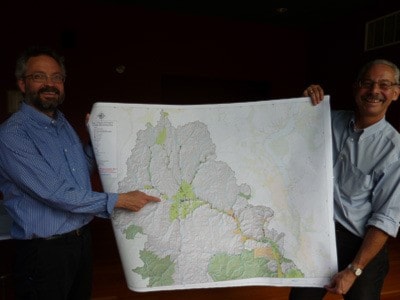The much anticipated report on what data is available on the Similkameen watershed is almost finished. Dr. Hugh Hamilton and Dr. Brian Guy of Summit Environmental Consultants presented the first draft of their report to the Similkameen Valley Planning Society, who commissioned the study.
“Compared to other watersheds of similar size and similar or larger population the Similkameen is well served for monitoring supply of surface water,” said Hamilton.
For surface water, there are good stream flow monitoring by four active stations on the main stream of the Similkameen river and active stations on all major tributaries and two Canada-B.C. long-term water quality monitoring sites.
“The background information is really good. You don’t have to spend five or ten years gathering data for studies,” explained Guy.
“I feel somewhat encouraged by what I’ve heard and read,” said SVPS Chair and RDOS Director Area “H”, Brad Hope. “I was pleased and surprised because I thought there were going to be lots of big gaps but it seems that there’s enough downstream monitoring to identify any changes.”
There are six groundwater observation wells for monitoring supply. Since 2005, it has been required that new wells are registered and the report maps all the 1,800 wells on record. The exact number of private wells is unknown. There is limited information on ground water quality.
“That’s one of the gaps,” said Hamilton, who recommends information is gathered on both the quality and actual use of ground water. “As the population grows it’s the ground water that’s going to supply it – that’s the big unknown.”
Summit Environmental Consultants looked at climate and changes in flow of the river. They found that the snow melt has started earlier and finished earlier with flows lower in late July into September. If this trend continues they consider there may be problems.
“We’re heading in the general direction of conflict between agriculture and fish in September,” cautioned Guy.
Overall the data is good for general understanding of the watershed but not for specific questions which would require detailed studies.
“It’s a good beginning,” said Keremeos Mayor, Walter Despot.
“If it’s between the glass being half full and half empty, the glass is half full but it’s still only half full. There’s still work to be done,” said.
As well as an inventory and assessment on actual water use, the report recommends a surface water - ground water interaction study, an initial in-stream flow needs to support fish populations, a summary of existing ground water quality data plus sampling at selected sites, an overview assessment of water storage opportunities and a development of a database to provide easy access to reports and data.
Princeton Mayor, Randy McLean felt it was important to have practical goals for the report recommendations, for example, in sustainable planning. “What we could end up with is the equivalent of an encyclopaedia we can refer to when we have development applications.”
Community consultation and input will be important.
“The formation of an advisory committee or advisory committees is crucial to help define what we have to do,” said Despot.
As soon as the final report is approved, it will be available to the public.
